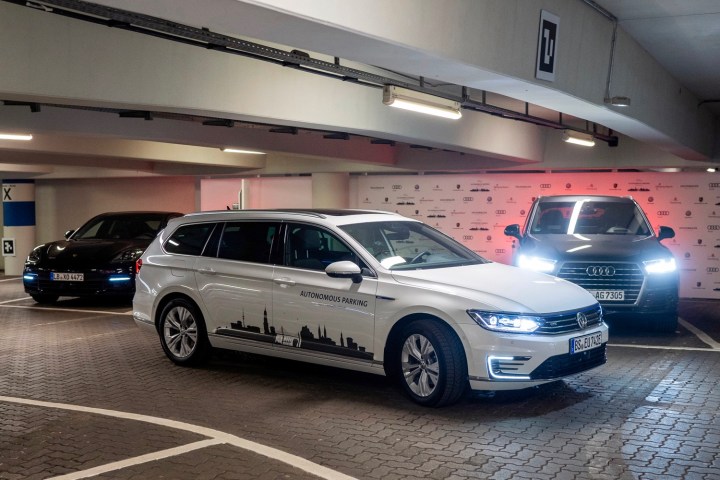 The Volkswagen Group is testing autonomous parking at Germany’s Hamburg Airport, using VW, Audi, and Porsche vehicles. The company hopes to get the system into production by 2020, and plans to offer a host of other services in concert with it.
The Volkswagen Group is testing autonomous parking at Germany’s Hamburg Airport, using VW, Audi, and Porsche vehicles. The company hopes to get the system into production by 2020, and plans to offer a host of other services in concert with it.
Volkswagen claimed that German drivers spend an average of 41 hours a year looking for parking spaces, while in the United States New Yorkers alone spend an average 107 hours a year looking for parking. This burns more fuel and increases traffic congestion. Autonomous parking could also serve as a stepping stone to autonomous driving, VW noted.
In Hamburg, drivers drop cars off at a designated parking garage. Cars then drive themselves to parking spaces, using map data to find a route and markers on the walls to orient themselves. Volkswagen noted that the relatively low-tech markers can be added to virtually any garage, making it easy to enable autonomous parking. The automaker also believes autonomous parking can be integrated with other services.
Once a car is parked, VW wants delivery services to be able to leave packages in its trunk. Under a system already tested in Berlin, delivery services are provided with the car’s location and one-time access in order to pop the trunk and drop off packages. Future Audis may be able to drive themselves through car washes or gas stations while their owners are away, according to VW, while electric Porsches may drive themselves to charging stations.
This tech could make life more convenient but, in what is probably the right move given the current state of self-driving cars, Volkswagen will roll it out slowly. Initially, autonomous parking will only be available in designated parking garages where human and vehicle traffic are separated. If the system performs satisfactorily, autonomous cars will be allowed to operate in the same areas as cars driven by humans.
Parking may be an easier way to introduce autonomous-driving tech to the public. While some people might be uneasy about relinquishing driving duties, no one enjoys parking. The lower speeds involved when maneuvering through parking garages would also lessen the severity of any crashes. But as with other forms of automation, Volkswagen will likely face public skepticism and regulatory issues.
Editors' Recommendations
- Waymo robotaxi attacked and set on fire in San Francisco
- Cruise woes prompt production halt of fully driverless van
- Dubai Police to deploy driverless patrol cars with AI smarts
- Cruise autonomous vehicle drives over woman just after she was hit by another car
- Cruise says it’s nearing approval for mass production of futuristic robotaxi

